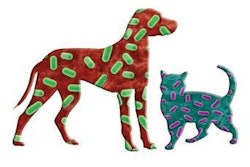
Pet obesity has been on the petfood industry’s radar for some time, but the latest numbers show that it’s a trend with (unfortunately for pets everywhere) serious staying power. On the upside, it provides an opportunity for petfood manufacturers to become the first line of defense in helping consumers help their pets lose weight and stay healthy.
The Association for Pet Obesity Prevention’s “2013 National Pet Obesity Awareness Day Survey” presents some somber numbers: An estimated 52.6% of US dogs are overweight or obese, with 16.7% obese; and an estimated 57.6% of US cats are overweight or obese, with 27.4% obese. That’s 43.8 million dogs and 55 million cats coming in at overweight or obese, according to the survey.
But it’s not just US pets in need of some portion control. The UK pet industry is calling for a clampdown on overfeeding after research by the Pet Food Manufacturers Association PFMA) revealed a disconnect between veterinarians and pet owners. While vets feel up to 45% of all pets they see are overweight (45% of dogs, 40% of cats, 28% of small animals and 15% of caged birds), two in three (63%) pet owners believe their pet is the correct weight. Further to this, only 37% of pet owners know how to determine whether their pet is overweight, and 68% of pet owners don’t follow professional guidelines when deciding portion size, according to the research.
“Overweight pets, like humans, can suffer from a myriad of health issues such as osteoarthritis, cardiovascular disease and diabetes,” says Zara Boland, BVSc BE MRCVS, the founder of UK-based Vet Voice Ltd. “There is nothing ‘cuddly’ about an overweight pet. Obesity is a disease in itself. It causes discomfort and illness that can result in both emotional distress and financial pressure for owners, and it has also been proven to reduce actual life length. We must continue pushing the pet health message until overweight pets are no longer an increasing and widespread concern.”
Dealing with overweight pets —and the associated conditions—is nothing new to the petfood industry. Specialty lines of food and treats line the shelves to help pet owners keep their pets’ weight under control. WellPet offers several wellness petfood formulas, including Complete Health Healthy Weight for dogs and cats and Holistic Select Weight Management for dogs and cats. Natura Pet Products offers a weight management formula for adult dogs and cats in their EVO line. Hill’s Pet Nutrition provides weight management products for both dogs and cats in their Prescription Diet line, including dry and wet petfood and treats among their selections. Nestlé Purina PetCare has overweight management petfoods for cats and dogs via their Veterinary Diets line.
But the needs are ever-changing, and it will largely fall on the petfood industry to stay on top of the obesity trend on not just the consumer front, but also the professional front. Veterinarians in the UK, for example, recommend that pet treats be given to pets occasionally and be taken into account at mealtimes, reducing the regular petfood ration accordingly. Whether consisting of dried, moist or a mixture of these foods, a daily diet suited to a pet’s life-stage and adhering to professional feeding guidelines is the best way to ensure pets receive optimum nutrition, according to vets.
These same veterinarians are running obesity clinics with high success rates (49.5%, according PFMA) and establishing initiatives focusing on pet weight management (see Sidebar: Pet weight management initiatives). Thanks to such efforts, there are more channels than ever for petfood manufacturers to work with and communicate with pet owners regarding the healthiest food options for pets.
Overall, the 83.3 million dogs and 95.6 million cats in the US alone provide significant opportunities for health-focused petfood manufacturers. When the statistics show that over half those dogs and cats fall into the same health category—overweight—it’s clear that avoiding that specialty market would be a mistake. Whether your company’s focus is on overall health or is broken into more specific categories that include weight management, the opportunities are there, and don’t look to be going anywhere any time soon.

















